Mitutoyo Telescoping Bore Gauge Sets
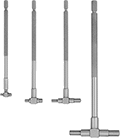
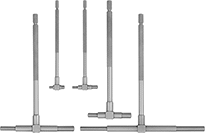

Inspect a variety of hole sizes with the gauges in these sets. Each has spring-loaded contacts on the probe, which expand inside holes to measure diameter. These gauges also detect deviations in roundness, so they can help you make sure parts don’t wear prematurely or run inefficiently. Use them for general checks when testing engine cylinders, machine components, and turbines. Designed to reach down into bores, they measure the diameter of deep holes better than calipers and inside-hole micrometers.
Once the contacts expand inside the hole, turn the screw on the handle to lock the contacts in place. To find the bore diameter, use a micrometer to measure the distance across the contacts.
| Number of Gauges | Measuring Range | Probe Type | Material | Includes | Manufacturer Model Number | Each | |
| 4 | 5/16"-2 1/8" | Telescoping | Steel | One gauge with 5/16"-1/2" measuring range One gauge with 1/2"-3/4" measuring range One gauge with 3/4"-1 1/4" measuring range One gauge with 1 1/4"-2 1/8" measuring range | 155-907 | 0000000 | 0000000 |
| 5 | 1/2"-6" | Telescoping | Steel | One gauge with 1/2"-3/4" measuring range One gauge with 3/4"-1 1/4" measuring range One gauge with 1 1/4"-2 1/8" measuring range One gauge with 2 1/8"-3 1/2" measuring range One gauge with 3 1/2"-6" measuring range | 155-904 | 0000000 | 000000 |
| 6 | 5/16"-6" | Telescoping | Steel | One gauge with 5/16"-1/2" measuring range One gauge with 1/2"-3/4" measuring range One gauge with 3/4"-1 1/4" measuring range One gauge with 1 1/4"-2 1/8" measuring range One gauge with 2 1/8"-3 1/2" measuring range One gauge with 3 1/2"-6" measuring range | 155-903 | 0000000 | 000000 |
| 6 | 8mm-150mm | Telescoping | Steel | One gauge with 8 mm-12.7 mm measuring range One gauge with 12.7 mm-19 mm measuring range One gauge with 19 mm-32 mm measuring range One gauge with 32 mm-54 mm measuring range One gauge with 54 mm-90 mm measuring range One gauge with 90 mm-150 mm measuring range | 155-905 | 0000000 | 000000 |
Starrett Telescoping Bore Gauge Sets
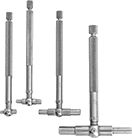
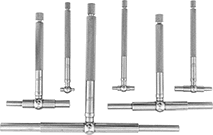
A different measuring range on each gauge makes these sets handy for checking a variety of hole sizes. Each gauge has spring-loaded contacts on the probe, which expand inside holes to measure diameter. Often used for general checks, these sets can make sure that engine cylinders, machine components, and turbines don’t deviate in roundness, which could lead to wear and inefficiency if undetected. Since the gauges reach into holes farther than calipers and inside-hole micrometers, they make it easier to inspect deep holes.
Once the contacts expand inside the hole, turn the screw on the handle to lock the contacts in place. To find the bore diameter, use a micrometer to measure the distance across the contacts.
| Number of Gauges | Measuring Range | Max. Dp. Measured | Probe Type | Material | Includes | Manufacturer Model Number | Each | |
| 4 | 5/16"-2 1/8" | 2" | Telescoping | Steel | One gauge with 5/16"-1/2" measuring range One gauge with 1/2"-3/4" measuring range One gauge with 3/4"-1 1/4" measuring range One gauge with 1 1/4"-2 1/8" measuring range | S579GZ | 000000 | 0000000 |
| 6 | 5/16"-6" | 2" | Telescoping | Steel | One gauge with 5/16"-1/2" measuring range One gauge with 1/2"-3/4" measuring range One gauge with 3/4"-1 1/4" measuring range One gauge with 1 1/4"-2 1/8" measuring range One gauge with 2 1/8"-3 1/2" measuring range One gauge with 3 1/2"-6" measuring range | S579HZ | 000000 | 000000 |
Starrett Telescoping Bore Gauges
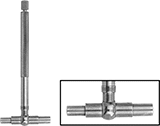
Versatile enough for general checks, these bore gauges have spring-loaded contacts on the end of their probe to expand inside holes. They’re often used in vehicle repairs and to test parts, such as engine cylinders, for deviations in roundness that could lead to wear. Since they reach father into holes than calipers and inside-hole micrometers, these gauges make it easier to measure a deep hole’s diameter.
Once the contacts expand inside the hole, turn the screw on the handle to lock the contacts in place. To find the bore diameter, use a micrometer to measure the distance across the contacts.
| Measuring Range | Max. Dp. Measured | Probe Type | Material | Handle Lg. | Manufacturer Model Number | Each | |
| 5/16"-1/2" | 2" | Telescoping | Steel | 2 7/8" | 579A | 000000 | 000000 |
| 1/2"-3/4" | 2" | Telescoping | Steel | 2 7/8" | 579B | 000000 | 00000 |
| 3/4"-1 1/4" | 2" | Telescoping | Steel | 2 7/8" | 579C | 000000 | 00000 |
| 1 1/4"-2 1/8" | 2" | Telescoping | Steel | 2 7/8" | 579D | 000000 | 00000 |
| 2 1/8"-3 1/2" | 2" | Telescoping | Steel | 2 7/8" | 579E | 000000 | 00000 |
| 3 1/2"-6" | 2" | Telescoping | Steel | 4" | 579F | 000000 | 00000 |
Economy Telescoping Bore Gauge Sets

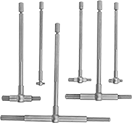
Measure a variety of hole diameters. These sets include gauges that use spring tension to expand the probe’s contacts inside of bores. Each gauge has a different measuring range, so they’re useful for general checks. Use them to test engine cylinders, machine components, and turbines for deviations in roundness that could lead to wear or inefficiency. Designed to reach down into bores, they measure the diameter of deep holes better than calipers and inside-hole micrometers.
Once the contacts expand inside the hole, turn the screw on the handle to lock the contacts in place. To find the bore diameter, use a micrometer to measure the distance across the contacts.
Gauges with titanium-nitride (TiN) coated steel contact points are best when you may come into contact with the bottom of a hole, or when working in harsh environments. They resist wear better than gauges with steel contact points.
| Number of Gauges | Measuring Range | Probe Type | Includes | Each | |
Chrome-Plated Brass with Steel Contact Point | |||||
|---|---|---|---|---|---|
| 4 | 5/16"-2 1/8" | Telescoping | One gauge with 5/16"-1/2" measuring range One gauge with 1/2"-3/4" measuring range One gauge with 3/4"-1 1/4" measuring range One gauge with 1 1/4"-2 1/8" measuring range | 0000000 | 000000 |
| 6 | 5/16"-6" | Telescoping | One gauge with 5/16"-1/2" measuring range One gauge with 1/2"-3/4" measuring range One gauge with 3/4"-1 1/4" measuring range One gauge with 1 1/4"-2 1/8" measuring range One gauge with 2 1/8"-3 1/2" measuring range One gauge with 3 1/2"-6" measuring range | 0000000 | 000000 |
Chrome-Plated Steel with Titanium-Nitride (TiN) Coated Steel Contact Point | |||||
| 4 | 5/16"-2 1/8" | Telescoping | One gauge with 5/16"-1/2" measuring range One gauge with 1/2"-3/4" measuring range One gauge with 3/4"-1 1/4" measuring range One gauge with 1 1/4"-2 1/8" measuring range | 00000000 | 00000 |
| 6 | 5/16"-6" | Telescoping | One gauge with 5/16"-1/2" measuring range One gauge with 1/2"-3/4" measuring range One gauge with 3/4"-1 1/4" measuring range One gauge with 1 1/4"-2 1/8" measuring range One gauge with 2 1/8"-3 1/2" measuring range One gauge with 3 1/2"-6" measuring range | 00000000 | 000000 |
Mitutoyo Telescoping Bore Gauges

Spring-loaded contacts on the end of the probe expand inside holes, making these bore gauges versatile enough for general checks. They’re often used to inspect vehicle parts, such as engine cylinders, for deviations in roundness that could lead to wear and inefficiency. They’re also useful for measuring a deep hole’s diameter. Compared to calipers and inside-hole micrometers, they reach deeper into holes to take measurements.
Once the contacts expand inside the hole, turn the screw on the handle to lock the contacts in place. To find the bore diameter, use a micrometer to measure the distance across the contacts.
| Measuring Range | Probe Type | Material | Handle Lg. | Manufacturer Model Number | Each | |
| 1/2"-3/4" | Telescoping | Steel | 4 1/4" | 155-122 | 00000000 | 000000 |
| 3/4"-1 1/4" | Telescoping | Steel | 4 1/4" | 155-123 | 00000000 | 00000 |
| 1 1/4"-2 1/8" | Telescoping | Steel | 5 7/8" | 155-124 | 00000000 | 00000 |
| 2 1/8"-3 1/2" | Telescoping | Steel | 5 7/8" | 155-125 | 00000000 | 00000 |
| 3 1/2"-6" | Telescoping | Steel | 5 7/8" | 155-126 | 00000000 | 00000 |
Economy Telescoping Bore Gauges
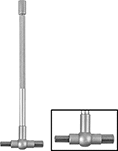
Position these gauges snugly within your bore to measure its diameter. Spring tension pushes the gauge’s two telescoping steel contacts against the walls of your bore. Once the contacts have expanded within the bore, turn the screw to lock them in place. To find the bore diameter, use a micrometer to measure the distance across the contacts.
| Measuring Range | Max. Dp. Measured | Probe Type | Material | Handle Lg. | Each | |
| 5/16"-1/2" | 2" | Telescoping | Steel | 4 1/2" | 0000000 | 000000 |
| 1/2"-3/4" | 2" | Telescoping | Steel | 4 1/2" | 0000000 | 00000 |
| 3/4"-1 1/4" | 2" | Telescoping | Steel | 4 1/2" | 0000000 | 00000 |
| 1 1/4"-2 1/8" | 2 1/8" | Telescoping | Steel | 5 3/8" | 0000000 | 00000 |
| 2 1/8"-3 1/2" | 2 1/4" | Telescoping | Steel | 5 3/8" | 0000000 | 00000 |
| 3 1/2"-6" | 2 1/4" | Telescoping | Steel | 5 3/8" | 0000000 | 00000 |

























